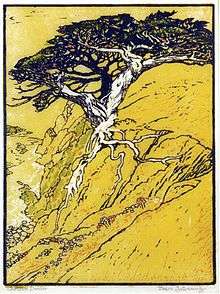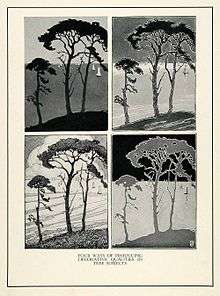Pedro Joseph de Lemos


Pedro Joseph de Lemos (25 May 1882 – 5 December 1954) was an American painter, printmaker, architect, illustrator, writer, lecturer and museum director in the San Francisco Bay Area. Prior to about 1930 he used the simpler name Pedro Lemos or Pedro J. Lemos; between 1931 and 1933 he changed the family name to de Lemos, believing that he was related to the Count de Lemos, patron of Cervantes. Much of his work was influenced by traditional Japanese woodblock printing and the Arts and Crafts Movement. He became prominent in the field of art education, and he designed several unusual buildings in Palo Alto and Carmel, California.[1]
Early life and education
Pedro's parents had emigrated from the Azores in 1872. His father Francisco (or Frank) was a shoemaker. Pedro was born on 25 May 1882 in Austin, Nevada. The family settled in Oakland, California in 1888. Pedro and his brothers Frank and John all followed careers in art.
As a teenager he studied art intermittently with Harry Stuart Fonda, Emile Gremke, and Mary Benton and at the California School of Design (now the San Francisco Art Institute). He returned to the latter school in 1910-11 and studied under Charles Judson, Harry Seawell, and Alice Chittenden. In 1913 he studied in New York with George Bridgman at the Art Students League and with Arthur Wesley Dow at Columbia.[2]
Early career
He was employed by Pacific Press Publishing Company in Oakland from 1900 to 1904. In 1904 he and his brother John started an engraving firm in San Francisco, which was destroyed in the 1906 earthquake and fire. In 1907 he married Reta Bailey of Berkeley and the three brothers, with two additional partners, started Lemos Illustrating Company in Oakland, continuing as Lemos Brothers, Artists and Engravers to 1911.[2] Later this became known as the Lemos Brothers Art and Photography Studio, which offered art classes in copper, leather and landscaping as well as the traditional media of drypoint, etching and illustrating.[3]
In 1911 he began teaching decorative design at the San Francisco Institute of Art. In late 1912 he was one of the founders the California Society of Etchers, and the following year he started offering the Institute's first classes in printmaking. Some of his students, such as William S. Rice and John Winkler, went on to achieve significant fame as printmakers. He helped organize the California print section of the 1915 Panama-Pacific International Exposition. He had five works in the exposition and received an honorable mention.
He served as director of the San Francisco Institute of Art from 1914 to 1917.
Later life
Under pressure to incorporate modernist art trends like cubism in the curriculum of the San Francisco Institute of Art, he resigned in the fall of 1917 to become director of the art museum and gallery at Stanford University. He continued in that role and teaching at Stanford until his retirement in 1945, and he organized an active schedule of diverse exhibitions. In March 1922 he presented at Stanford the first solo exhibition of his own work, a collection of pastels, and in August 1922 an article about him was featured in the American Magazine of Art. He continued to exhibit his work in many media at Stanford and elsewhere, and for several years he taught summer art classes as far away as Chicago.[2]
He became a prolific author of articles and books on Mexican and Native American crafts and on the teaching of arts and crafts. In 1920 he and his brother John T. Lemos co-authored Art Simplified: A Book of Practical Art for Advertisers, Commercial Artists, Teachers and Students, published by the Prang Company. Applied Art: Drawing, Painting, Design and Handicraft (Pacific Press Publishing Association, 1920) became a popular textbook for elementary and high school art classes that was revised and reprinted more than a dozen times through the 1940s. Many short pieces appeared in the SchoolArts Magazine, where Lemos served as Editor—in-Chief from 1919 to 1950. The 1922 book Color Cement Handicraft by Pedro and Reta Lemos, with an emphasis on decorative tiles, was reprinted in 2007 as Arts & Crafts Era Concrete Projects.[4]
In 1929 he became involved in the founding, design and administration of the Allied Arts Guild in Menlo Park. He and his wife had already engaged in developing similar groups of art studios and shops in Carmel and Palo Alto.[2] From 1931 to 1941 they developed their own home of nearly 9,000 square feet on Waverley Oaks in Palo Alto. This "Hacienda" is on the National Register of Historic Places.[5] In the 1940s they began work on a "Storybook" house in Pebble Beach, completing only the garage and caretaker's cottage.[3]
He died in his home in Palo Alto on 5 December 1954.
Associations
Lemos was elected the first president of the Carmel Art Association in August 1927, but refused to attend most of the meetings in a bitter dispute over juried exhibitions.[2] He also belonged to the Bohemian Club, Palo Alto Art Association, Chicago Society of Etchers, Pacific Art League, and other organizations. In 1943 he was elected a Fellow of the Royal Society of Arts in London.[6][7]
References
- ↑ Edwards, Robert W. (2015). Pedro de Lemos, Lasting Impressions: Works on Paper. Worcester, Mass.: Davis Publications Inc. pp. 4–111. ISBN 9781615284054.
- 1 2 3 4 5 Edwards, Robert W. (2012). Jennie V. Cannon: The Untold History of the Carmel and Berkeley Art Colonies, Vol. 1. Oakland, Calif.: East Bay Heritage Project. pp. 207–220, 234, 480–484. ISBN 9781467545679. An online facsimile of the entire text of Vol. 1 is posted on the Traditional Fine Arts Organization website (http://www.tfaoi.com/aa/10aa/10aa557.htm).
- 1 2 Casita deLemos – The Gingerbread House
- ↑ Lemos, Pedro J. (2007 (reprint of 1922 ed.)). Arts & Crafts Era Concrete Projects. Atglen, Pa.: Schiffer Publishing. ISBN 9780764328336. Check date values in:
|date=(help) - ↑ "Hacienda de Lemos". Palo Alto Stanford Heritage. Retrieved 25 August 2014.
- ↑ International Fine Print Dealers Association
- ↑ The Annex Galleries